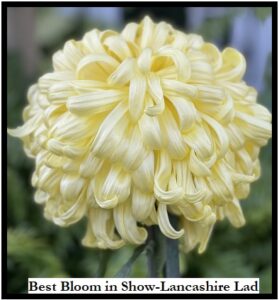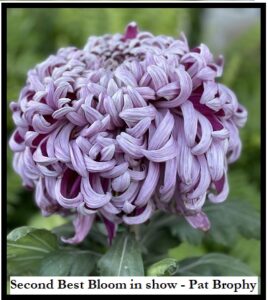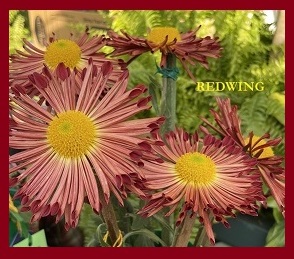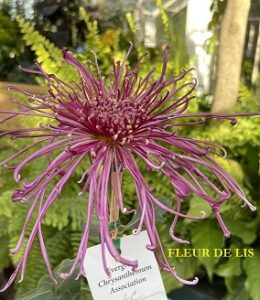EVERGREEN CHRYSANTHEMUM ASSOCIATION
Seattle, Washington
ECAMumClub.org
Email us at: steve at ecamumclub dot org
HAPPY Final Potting Season!
MEETING OF THE ECA – THURSDAY JUNE 13, 2013 at 7 PM at the Seattle Police Athletic Association Office (SPAA) site at 11030 East Marginal Way South, Tukwila.
June is a particularly busy month in growing mums so hope you can attend the meeting and bring your questions!
WHITE RUST ALERT From Chris Brookes
I hope everyone is well aware of the outbreak of “White Rust” within ECA and also the purchase of “Eagle” fungicide to try and control the outbreak. I maintain an active correspondence with other professional growers around the world and yesterday I mentioned our problem to Ivor Mace in the UK. He asked for details of the active ingredient in Eagle (It’s Myclobutahil) and as you can see from his second email (copy attached) whilst this fungicide is accepted in the USA, it is not accepted by the Agricultural Authorities in the UK as a solution to “white rust” removal. In fact Ivor states there are no known fungicides that can guarantee the removal of “White Rust.
My message is simple; White Rust is a very dangerous problem that can spread rapidly to all Chrysanthemums and other nearby plants. It may well be possible to retard further infection by using Eagle, but I very much doubt we can spray our way out of the problem so long as there is foliage on the plants. If this is correct then impacted ECA members need to burn or bury all infected plants immediately. All other plants in the greenhouse should be repeatedly sprayed with Eagle until well after the flower stage.
Chris Brookes
Extract from Ivors first email:
Chris
What is the active ingredient of Eagle, We have a new fungicide called “Signum” it has boscalid & pyraclostrobin which some growers say has good control. I have only had white rust twice and I am convinced the only time you can eradicate it is after flowering, when you have cut back and you can be sure you are covering every bit of the stool with the fungicide. I sprayed for 6 consecutive weeks and got rid of it both times and it never returned. At this time of year you can spray everything with a relatively small amount of fungicide. Both times I got white rust I got it in on plants from another grower, nowadays I try to get a stool and put it through my winter spraying programme. There are 2 nurseries over here that dish out white rust annually. Our society gave one of them their Gold Medal, personally I think they should have shot him. Single handedly he has done more to instigate the decline of chrysanthemums in the UK than anyone on earth. Both of these spray in the growing season and never knock it all out.
Regards
Ivor
The following additional information came in from Ivor today. In
yesterdays emails he made reference to his winter spraying program
after getting white rust and I asked him what sprays he was using
His reply is given below.
The two sprays referenced have different Brand names in the USA.
Bumper is: Propaconazol which is sold in the USA under the brand
name “Banner Max”
Amister is: Azoxistrobin a systemic and appears to be sold under the
brand name Caravan G.
At some point ECA will have to come to a forward recommended plan of
action and suspect it will be something of trial and error by those
who had infected plants.
Regards
Chris
Chris
I set my thermostat at about 35f. By the end of November I have
cut the stools down and got them up on the benches. I spray once a
week with Bumper and an insecticide, then the next week I use
Amistar, I repeat this for 6 weeks which takes me up to Christmas.
I suppose I could cut back on this now because I haven’t had white
rust for over 10 years.
Your members will need to spray a few times now to get it under
control and then spray every fortnight till the end of the
season. Then in the winter when the stools are bare (and I would
cut back all the basal growths) he can spray weekly for 6 weeks, it
only takes a small amount to spray bare stools.
Regards
Ivor
Here are pics of what White Rust looks like on your plants from Google Images.
If you suspect White Rust on your plants, contact one of the club elders.
Here is information on fungicide sources and application:
Material Safety and Data Sheet (MSDS)
IMPORTANT NOTE: If you are going to uses any of these products, PLEASE PLEASE PLEASE read the MSDS SHEETS below and use proper protection to prevent unwanted exposure to yourself and others.
Daconil Fungicide Concentrate
available from WalMart, Home Depot, and McLendons
active ingredient Acibenaolar-S-Methyl and chlorothalonil
MSDS SHEET
Strike 50 from Ron Elliott
active ingredient Traidimefon
MSDS SHEET
http://www.kellysolutions.com/erenewals/documentsubmit/KellyData/MD/pesticide/MSDS/59807/432-1367-59807/432-1367-59807_STRIKE_50_WDG_1_31_2007_5_56_08_PM.pdf
Eagle 20
available from Ron Elliott
active ingredient Myclobutanil
MSDS SHEET
YEARBOOKS
We will bring additional 2013 ECA Yearbooks to the June Meeting for those of you who need another copy. Thanks again to Mark Ross for again taking on this big project!
UPCOMING EVENTS
Mark your calendars for the following events:
Garden Tour/Potluck – August 11
Puyallup Fair – September 6 – 22
Fall Show at Furney’s – October 25 – 27 (with set up on Oct. 23, 1 pm. Bloom
Prep. Oct. 24)
Awards Banquet at Angelos– November 14
ECA SUMMER PICNIC
SIGN UP FOR THE SUMMER PICNIC – at or before the June meeting when there will be a drawing for two FREE entry tickets to the Bloedel Reserve. (you must be present at the meeting to win)
Already signed up are: Richard Blaisdell. John Harden, Mark Ross, Anne Schreibe, Nancy Halleen, Don Stark, & Steve Backstrom.
Picnic Time: If you do not feel the Bloedel Reserve is for you then simply come across on the 10:25 or 11.25 ferry and join everyone at lunch time. Janet will be at home all morning to greet those who simply want a cup of coffee, a rest and to enjoy the view. It takes about 45 minutes from sailing time to my house.
Bloedel Reserve Walkers
Entry fees to Bloedel Reserve must be paid to ECA by the July meeting latest (Adults $13, Seniors $9) We need to make payment prior to arrival. Good photographic images of the 150 acres within the Reserve can be found on http://www.bloedelreserve.org/.
Car pooling: The final list of members going to Bloedel Reserve will be published following the July meeting. Look for others on the list who could car pool with you. Members to form their own car pools. No ECA oversight. South King County and Kitsap County members may find it more convenient to drive around V’s the ferry.
Bainbridge Island Ferry Crossing: Member cars need to be in line at the downtown ferry terminal by 09:15 on Sunday morning, August 11th 2013. The ferry sails at 09:35am. Walk on passengers are OK until 2minutes before sailing.
Meeting Point: 10:30 am at the Bloedel Reserve gate. More detailed instructions to follow later. The reserve is located on the North West corner of the island (almost at the Agate Pass bridge.) I will be at the gate from 10:15am to identify paid ECA members coming from the ferry or driving around.
Picnic Lunch: Anticipate being at Bloedel Reserve for approximately almost 2.0 hours and then it’s a 10 minute drive back to my house. Estimate lunch will probably be around 12:30pm. More details to follow.
Parking: A little complicated as there will be three different parking spots at or nearby our home – more information later.
Returning to Seattle: It’s embarrassing when guests announce they want to leave, only to realize had they said something five minutes earlier there were good connections. We post return sailing times and guests choose which ferry they want to make. Sunday afternoons can be busy. Plan to leave our house at least 45 minutes ahead of your chosen sailing time. Hopefully this is adequate time to avoid being held up with ferry overloads.
PLANT CULTURE and SUPPLIES –Cultural suggestions are attached for June and will be discussed at the meeting. Remember to contact Mark Ross prior to the June (by Monday the 11th) meeting for soilless and supplies as needed.
Alert: This June will be the last delivery of M&R mix for the year so get your orders in to cover you needs through this year – maybe some left over for starting in Dec./Jan. Call your orders in by June 11th to give us plenty of lead time to get the supplies. Call orders to: Don Stark or Mark Ross.
If we are mailing you the monthly notice and you have an email address, please send an email to Steve Joyner.
TO DO LIST for June (revised DRS May 2012)
Stopping:
Most plants are stopped April 15 through June 1, including the Early English classes. Keep your stop list handy and follow it rigorously. The calendar doesn’t move backwards. For #1 and #2 varieties the English literature recommends a fairly hard pinch; that is pinching 6-8 leafs down from the growing tip. For the incurves, #3, #13, #23 pinch the smallest portion of the growing tip to get more uniform growth of the laterals. For all varieties, fertilize 1-2 weeks before pinching to produce more laterals. This is especially true for the Fairweathers.
Final Potting into 8”, 9” or 10” pots. (Or maybe in the garden soil)
Preparation
Wash clay pots in a mild Clorox solution, then rinse in clear water. Keep washed pot in the rinse water for 4-5 minutes to assure getting the Clorox out of the clay. Change rinse water occasionally. Plastic pots don’t need long rinse time, but could benefit from washing with Clorox solution.
Prepare final potting mix. Starting with our basic M&R mix, we add compost or good loamy soil, some screened coarse pumice, a small amount of well composted horse manure, and alfalfa meal.
The component mixture (by volume) is then:
M&R Soilless-6 parts, Compost or loam-4 parts, Coarse pumice-1 part
Horse manure-1/2 part, Alfalfa Meal- a hand full.
The Compost or loam is added primarily to ensure a lot of trace elements and to improve the moisture holding capability of the mix so that the pots don’t require watering twice a day for instance. The horse manure provides lots of microbes to quicken the soil break down and release of the nutrients. Many growers have gone into the final potting using the straight M&R mix with some significant success.
Potting (Pot on when the ring of roots around the bottom of the pot is semi root bound.) Cover drain holes in bottom of clay pots with a piece of broken crock to keep drain clear. Put a layer of broken sod or course pumice in the bottom of pot, then cover with 1 or 2 inches of the final (9”) mix. Place the 6” root ball on top of the 9” mix and fill around with the 9” mix. The top of the root ball should be 1+ inch below the top of the pot. Do not pack the mix except as necessary to hold the plant and stake in place. Stake with shingle or bamboo stick.
Add Marathon Systemic at this time to control black aphids. Sprinkle ½ tspn. Marathon on top of soil when repotting plant, add a thin layer of mix over the top, then water moderately.
Note: When potting on occurs after June 1, Consider dropping down one pot size pot because the roots will not have time to fill the bigger pots. # 1 & #2 cultivars, 9” max, 8” could be used. #3s, 8” max.
Feeding and pest management
· After 3 weeks in final pot start summer feeding program. ` 1 1 to 2 Tsp. Peters 20-10-20 per gallon water, once a week.
Note: Some plants will thrive with the heavier solution, while others
may not like so much fertilizer. Watch the leaves to gauge the fertilizer needed. If leaves become hard and curl up you are overfeeding. If leaves are somewhat weak and lighter green then more fertilizer would help. Miracle Grow is also used quite successfully by some during this summer stage.
· If plants are yellowish, first try drying them out. If drying the plant is unsuccessful, feed ½ tsp. Epsom Salts per plant. Leaf feeding of liquid iron such as Greenall or Sequesterine also helps green up the plant. Follow product directions. Do not over feed Liquid Iron.
· Review your pest management program every 2 weeks,
Marathon systemic is the most effective black aphid control.
Diazinon and most rose insecticides are somewhat less effective, and require spraying every 2 weeks, as they are contact insecticides. Spray every two weeks with a fungicide. Ortho Funginex is recommended. Other fungicides will work well if used regularly. If fungus gets away and is growing fast, a fungicide used to control early blight in tomatoes will really shut it down. I use Monterey “Bravo” for such control.
4. Lateral Control
As side laterals develop after the final pinch, select the number of laterals to carry through the summer and remove all other side shoots. Generally the topmost lateral below the stem break is removed, as it is the weakest lateral structurally and easily broken off by accident. At this early stage you should carry 1-2 more lateral than you want at the bloom stage. An old saying goes: “I grow 2 for me and one for the bug.”
Surplus laterals are removed later in the summer using the following guide.
For #1 & #2 cultivars, carry 2 or 3 laterals initially, cull to 1 or 2 in Aug.
For #3 cultivars, carry 5 laterals and cull Sept. or Oct.
For #4 & b#5 cultivars, carry 4 to 5 laterals and cull to 2 to 3 in Sept.
For Earlies (13-15 and 23-25) carry 4-5 laterals and cull to 2-3 in Sept.
For Spiders, Quills, Spoons, Singles etc. follow the guide for #4 and #5.
Note: Cutting back to the few laterals seems to be a most difficult task for the novice. You must do it however if you wish to get large blooms.
5. Staking.
By now all plants will require staking. A 16-24 in stake should be placed along the main plant stem and tied to it to support and protect the plant. As the side laterals develop it will be necessary to add longer stakes that can support each lateral all the way to bud development. Care must be exercised so as to not spread the new laterals too far apart when staking, as one or more could be broken off. In other words let the laterals grow till they can be easily tied to the new stakes.




